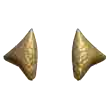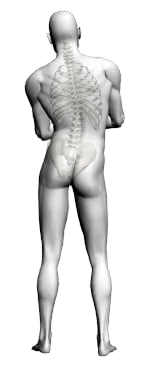






This area shows organs in the human body affected by the selected vertebrae. Additional options include rotating the body and a close up of the organ.
Area showing nerve impulses affected by selected vertebrae.
Area showing enlarged view of vertebrae and name of selected vertebrae.
Click anywhere on the spine to see the affected organs and nerves.
All of the functions related to The Amazing Human Body are controlled and coordinated by the extensive neural network continually sending and receiving electrical impulses to and from the brain in order to coordinate our optimal health. Interference or stresses in any part of the nerve system may result in health problems in a variety of different areas throughout our bodies. Take a moment and explore (by moving your mouse over the different levels of the spine) which areas of the body are influenced by the different ares of our spine. You will be amazed at how the spine and nerve system are interrelated and connected to every aspect of our expression of health and wellness.

Various distensible membranous sacs, such as the urinary bladder or the swim bladder, that serve as receptacles for fluid or gas.

The portion of the intestine that extends from the ileum to the anus, forming an arch around the convolutions of the small intestine and including the cecum, colon, rectum, and anal canal.

A pair of organs in the dorsal region of the vertebrate abdominal cavity, functioning to maintain proper water and electrolyte balance, regulate acid-base concentration, and filter the blood of metabolic wastes, which are then excreted as urine.

The narrow, winding, upper part of the intestine where digestion is completed and nutrients are absorbed by the blood. It extends from the pylorus to the cecum and consists of the duodenum, the jejunum, and the ileum.

Either of two small, dissimilarly shaped endocrine glands, one located above each kidney, consisting of the cortex, which secretes several steroid hormones and the medulla, which secretes epinephrine.

A large, reddish-brown, glandular vertebrate organ located in the upper right portion of the abdominal cavity that secretes bile and is active in the formation of certain blood proteins and in the metabolism of carbohydrates, fats and proteins.

A large, highly vascular lymphoid organ, lying in the human body to the left of the stomach below the diaphragm, serving to store blood, disintegrate old blood cells, filter foreign substances from the blood, and produce lymphocytes.

A long, irregularly shaped gland in vertebrates, lying behind the stomach, that secretes pancreatic juice into the duodenum and insulin, glucagon, and somatostatin into the bloodstream.

Stomach – The enlarged, saclike portion of the alimentary canal, one of the principal organs of digestion, located in vertebrates between the esophagus and the small intestine. Esophagus – The muscular membranous tube for the passage of food from the pharynx to the stomach; the gullet.

The chambered muscular organ in vertebrates that pumps blood received from the veins into the arteries, thereby maintaining the flow of blood through the entire circulatory system.

An artery that originates on the right from the brachiocephalic artery and on the left from the aortic arch, runs upward into the neck and divides opposite the upper border of the thyroid cartilage, with the external and internal carotid arteries as its terminal branches.

Two spongy, saclike respiratory organs in most vertebrates,occupying the chest cavity together with the heart and functioning to remove carbon dioxide from the blood and provide it with oxygen.

An artery that carries venous blood from the right ventricle of the heart to the lungs.

Either of the pair of salivary glands situated below and in front of each ear.

A two-lobed endocrine gland found in all vertebrates, located in front of and on either side of the trachea in humans and producing various hormones, such as triiodothyronine and calcitonin.

Either of two salivary glands situated in the mucus membrane on the floor of the mouth beneath the tongue.

Either of two salivary glands situated in the neck near the lower edge of each side of the mandible and emptying into the submandibular duct.

Various air-filled cavities in the bones of the skull, especially one communicating with the nostrils.

A pair of hollow structures located in bony sockets of the skull, functioning together or independently, each having a lens capable of focusing incident light on an internal photosensitive retina from which nerve impulses are sent to the brain; the vertebrate organ of vision.

Glands from the posterior two-thirds of the nasal cavities and from the accessory air sinuses Lymphatic Vessels of the mouth.

The portion of the vertebrate central nervous system that is enclosed within the cranium, continuous with the spinal cord, and composed of gray matter and white matter. It is the primary center for activities, receiving and interpreting sensory impulses, and transmitting information to the muscles and body organs. It is also the seat of consciousness, thought, memory, and emotion.















Shown here is a segment of your spine. The spinal cord passes along a passageway made up by your vertebrae. The spinal cord connects every cell, tissue and organ of your body to your brain through a pair of nerve roots that branch off from it. Millions of impulses flow continuously from the brain, along the spinal cord and out to every organ and tissue and back again, keeping a running monitor of how things are functioning. Nerves control all of your organs and tissues.
Subluxation means misalignment, a vertebral subluxation refers to a spinal bone which has become misaligned. Pressure applied to nerves because of a subluxation, can cause weakness, numbness and poor performance.
Likewise, if nerves are rubbed, stretched or otherwise irritated, they can develop hyperactive impulses that cause pain, muscle spasms, overactive organ function and other symptoms of poor health.
Subluxations can be caused by a slip & fall, an auto injury accident, effects of drug, alcohol, pollution and even emotional stress.

When your spine is continually neglected, you may enter various phases of subluxation degeneration. This progressively worsening condition is often the result of neglected spinal misalignment, injury, or misalignment. Because obvious symptoms are not always present, this condition can exist for years without detection.
Degeneration of the spine can begin with an injury to the disc of the spine. Small Tears start forming in the Annulus or Disc Wall.
Osteophytes or Bone Spurs start to form as the tear tries to heal. The continued cycle of tearing and scarring cause the disc wall to weaken over time.
After some time, the disc becomes damaged and leaks material out of its Nucleus. This causes the disc to collapse.
Bones Spurs Continue to form, further limiting range of motion and nerve signal impulses to the rest of the body.
Degeneration severity is categorized by 4 phases.
Phase I
Phase II
Phase III
Phase IV
Seen in subluxations present up to 15 years.
Characterized by loss or change in normal curve in spine (lordotic curve).
Disc spaces have begun to exhibit slight changes in shape and buffer.
Overall motion probably not affected.
Chiropractic reconstructive care for phase 1 can take 6-12 months.
80 percent of people with phase 1 subluxation have no pain.
Therefore if left untreated phase 1 continues to progress with time until it eventually reaches phase 2.
Seen in subluxations present from 15-35 years.
Characterized by further loss of spinal curve.
Patients show reduction in range of motion.
Bone spurs begin to build up.
Disc spaces between the affected vertebrae are noticeably narrower and may appear to flatten.
Some people may not exhibit symptoms, some start to feel stiff or achy.
Chiropractic reconstructive care for patients in phase ranges from 1 to 2 years.
If left untreated, phase 2 subluxation slowly advances to the next phase.
Seen in subluxations present from 30-50 years.
Abnormal curvature.
Disc spaces are vastly decreased and changed.
Bone spurs are abundant.
Patients have restricted range of motion.
Chiropractic reconstructive care from 2 to 4 years.
If left untreated, phase 3 subluxation advances to the most serious phase.
Seen in subluxations present for more than 50 years.
Grave condition that negatively affects patients longevity and quality of life.
Severe structural changes.
Vertebrae exhibit massive bone spurs.
Disc buffers are very close.
Patients in phase 4 have serious structural and neurological problems, but chiropractic care can still help.
Many patients in phase 4 that seek chiropractic care, report improvements in mobility and quality of life.

It should be noted every patient is different. Degeneration and healing speeds vary with every patient, however the more time a subluxation has been left untreated, the longer the road to recovery will be. The time to see your chiropractor is today!
Alpharetta, Georgia 30009
Powered By The 100 Year Lifestyle Chiropractor Network